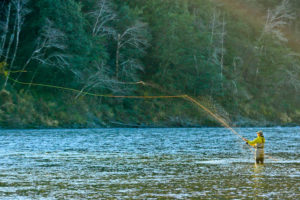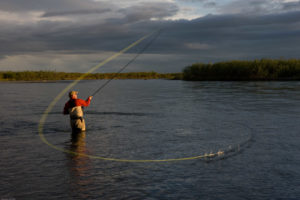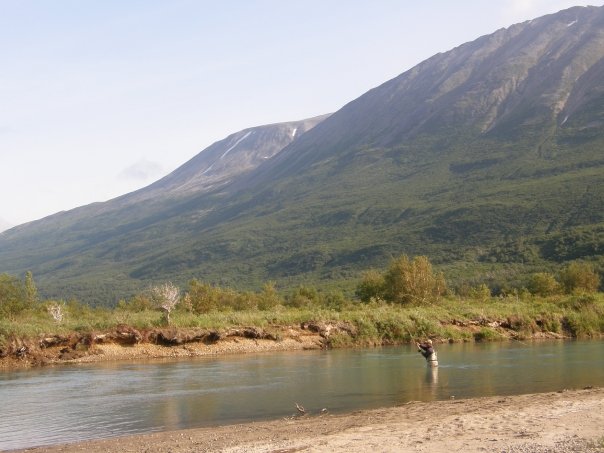Early summer mornings or the frosty dawn in fall signals an insatiable urge in many fly fishermen to awaken. Steelhead instinctively migrate to the river of their birth. These mythical fish bring dreams, hopes, and confusion with them as they arrive in such revered rivers as the Ho, Bulkley, and The Deschutes. The synchronicity is amazing. Pursuing steelhead is an obsession marked with opinions and superstitions that border on maniacal for many anglers. There are many techniques to catch these elusive fish. However, the evolution and growth of the use of two-handed rods have sown even more chest-thumping arguments and confused stares on the river bank or fly shop than ever before. Selecting the right Spey line is one focal point of these arguments, so we are going to share our expertise on the subject.
Which One Is Right For You? Scandinavian or Skagit or Traditional…..Hmm?
Fortunately, this question is truly not as important when selecting the proper Spey line as: What is your casting skill? This requires honesty and a tad bit of pride swallowing

to truly select the right line for yourself. Here are the basic differences between these three types of lines that will give you the first level of information to make an informed line decision.
-
Traditional Spey Lines
These lines usually have a long head length – usually greater than 50‘ and have an integrated running line. Traditional Spey lines let the angler strip less line in-between each cast. This makes casting these lines much a much more efficient fishing experience. This is the main advantage over the Scandinavian and Skagit type of lines. Simply stated, the better the caster you are, the longer the head length of line you will be able to cast. Sinking tips and heavy flies are much more difficult to cast on traditional Spey Lines.
-
Scandinavian Spey Lines(Scandi)
They usually have shooting heads with long front tapers, which are very pleasant to cast. Short heads, usually no longer than three times the length of the rod are the norm for Scandinavian lines. This characteristic makes “Scandi” lines easier to cast than traditional Spey lines and are a great choice for smaller rivers and tight casting situations. Tight loops are assured with the long tapers of Scandis making them the perfect choice for fishing normal sized flies and unweighted flies.
-
Skagit Spey Lines
These lines usually have a head length of fewer than three times the rod length. Generally, Skagit lines need a front tip added before they are ready to fish. Adding a floating or sinking tip usually makes other two-handed lines more difficult to cast. This is the opposite of Skagit lines – they lift weight very easily. Large flies and heavy tips can’t be casted with any other type of line more easily. The same goes for the heaviest sink tips, making Skagit lines perfect for winter steelhead in the coldest streams. The short head length makes a Skagit line a great line for beginners. The downside is the splashy presentation and the large amount of line that has to be stripped in before each cast.
Boy! He Has a Big (Spey Line) Head!

So now how do you pick the proper head for your two-handed rod? I would go into the D-Loop technical stuff and anchor point mumbo-jumbo but this is about line selection – not specific casting dynamics. Time for a list of a few things that you should consider when choosing the length of head you will need to have a splendid day of casting a thousand times.
A Few Things to Consider When Choosing Your Spey Line Head
- Rod Length – Short rod, shorter head and a longer rod, longer head. The reason for this rule will become explicitly clear when you make your first attempt casting a T-14 tip with a lead eyed Intruder.
- Casting Skill – First, be as good at it as you think you are. Secondly, the longer the head length the better the Spey caster you should be.
- Sink Tips – The sinking tip or the heavy fly or a combination of the two are the banes of even the best two-handed casters. If you are going to use these two things then a line with a short head will be easier to clear and safer to cast.
- Economy of Motion – Big term, simple definition: How quickly can you recast your line at the end of the fly’s swing. Skagit heads require more line to be stripped in before casting. This can make for a long day if making numerous long casts. Longer heads like Scandis require less running line to be retrieved to cast making them somewhat faster to cast again.
- River Size – if it is a smaller river you are fishing, you don’t need a long head.
- Frozen Guides, UGH! – If you have yet to experience this then you should buy a lottery ticket. The less line that has to be retrieved during such pleasant freezing conditions, the less likely the line is to freeze into iced-up guides. A longer head on your Spey line will make for a much happier day in freezing conditions.
Simplify and Listen
Selecting the appropriate Spey line is instrumental in determining your success when chasing anadromous fish like steelhead, Pacific Salmon species, or Atlantic Salmon with a two-handed rod. There is a vast amount of information and misinformation out there on how to pick a Spey line. The keys to choosing the right line are to know your casting skill level, the fishing environment where you will be casting, rod length to line ratio (3:1 head length to rod length on average), and ultimately you might want to talk to an equipment specialist at your local fly shop or drop us an email here at Always A Good Day.


